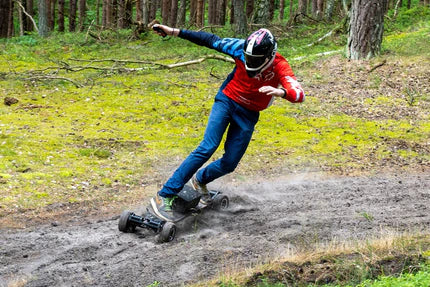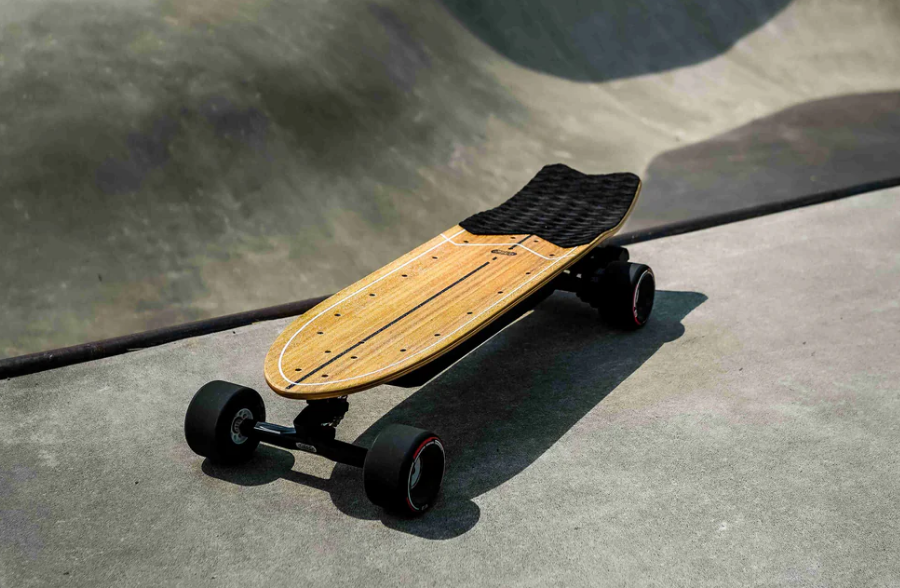Have you ever enjoyed the convenience and fun of riding an electric skateboard? Perhaps you've watched someone else glide by you like they're on a flying carpet, and you've always wondered how it all works. What makes these boards unique? Knowing the ins and outs of electric skateboard mechanics can improve your riding experience while also keeping you safe. To help you better understand electric skateboards, this article will examine their workings, highlight their key components, provide some important safety advice, and discuss the regulations around their use.
What Are the Main Parts of an Electric Skateboard?
An electric skateboard is a skateboard with a motor to assist with propulsion. This makes riding it easier and more enjoyable as you can do it without exerting as much force. To really get how electric skateboards work, it's helpful to know about their main parts, since each one plays an important role in how the board functions.

Deck
The deck is the part of the electric skateboard that you stand on while riding. Think of it as the main platform that supports everything else. Electric skateboard decks are usually made from several types of materials, including wood, composite, or plastic.
Decks come in two primary varieties: longboards and shortboards. Longboards are excellent for novices and smooth rides because of their longer, wider decks, which provide stability. Experienced riders find shorter, lighter boards appealing in urban environments or skate parks because they can perform rapid turns and tricks with more dexterity.
Battery
The biggest, heaviest, and priciest component of an electric skateboard is the battery. What fundamentally sets an electric skateboard apart from a conventional one is its horsepower. It would just be a regular skateboard, without battery supplying energy to the motor.
Lithium-ion batteries are used in the majority of electric skateboards because they offer an excellent weight-to-power ratio. As a result, e-skaters can experience an effective ride without gaining undue heft. The battery's capacity, expressed in watt-hours (Wh) or milliampere-hours (mAh), is important since it dictates how far you can go between charges. If your battery has a larger mAh or Wh rating, you can ride farther between charges since it can store more energy.
Motor
The motor is necessary for the electric skateboard to be propelled and has a major impact on speed. Watts (W) are used to rate power; more wattage corresponds to faster speeds and better ability to climb hills. Typically, the motors used in electric skateboards are either belt-driven or hub-driven.
- Hub motors are built into the wheels and they have fewer moving parts, so they are quieter and require less maintenance. They might not have the torque necessary for rapid acceleration, though.
- Belt-driven motors, mounted close to the wheels and using a belt to transfer power from the motor to the wheels, offer greater torque and quicker starts. They are perfect for climbing steep hills, but they can be noisier and need more upkeep.
Wheels
An electric skateboard's wheels are essential to its handling and riding quality. Usually composed of urethane, they provide traction and toughness. The wheels' hardness and size have a significant impact on performance. Wheels can be classified into three categories based on riding conditions:
| Type of Wheel | Description | Ideal For | Common Skateboard Types |
| Street Wheels | Usually smaller and harder, designed for smooth, flat surfaces. | Urban riding and tricks | Street skateboards, trick boards |
| All-Terrain Wheels | Larger and softer, built to handle rough terrains like gravel or dirt. | Comfortable rides on uneven surfaces | All-terrain skateboards, off-road boards |
| Urban-Terrain Wheels | A middle ground between street and all-terrain wheels, with moderate size and hardness. | Variety of surfaces, including city streets and light trails | Commuter boards, hybrid skateboards |
The durometer rating is another index that indicates the hardness of skateboard wheels; larger values denote harder wheels and lower numbers suggest softer wheels. The Shore A scale is used for this classification.
- Soft wheels: These, ranging from 75A to 83A, offer superior grip and shock absorption and are best suited for rugged terrain; nevertheless, they may wear out more quickly on flat ground.
- Hard Wheels: Available in sizes 84A to 90A+, these wheels are more suited for smooth surfaces with excellent speed. They are less grippy but more robust.
Braking System
The braking mechanism, which enables riders to efficiently slow down or stop, is crucial for safety when riding an electric skateboard. Riders can improve overall safety and speed management by being aware of the various kinds of braking systems. Electronic, mechanical, and regenerative brakes are the three main categories of brakes.
| Type of Brake | How It Works | Advantages | Disadvantages |
| Electronic Brakes | Use an electronic control system to reduce motor power, slowing the skateboard smoothly. | Smooth and controlled stopping; easy to use | May be less effective in wet conditions |
| Mechanical Brakes | Function like traditional brakes, using friction from pads against the wheel to slow it down. | Reliable and straightforward; effective at all speeds | Can wear out over time; may require maintenance |
| Regenerative Brakes | Convert kinetic energy back into electrical energy while slowing down, slightly recharging the battery. | Extends battery range and minimizes wear on components | Can be less responsive than other brake types |

Electronic Speed Controller (ESC)
An electric skateboard's Electronic Speed Controller (ESC) is an essential part serving as the system's brain. It converts remote control commands into actual board movements and controls the amount of power sent to the motor. It lets the rider to manage both acceleration and deceleration when they press the throttle on the remote. This regulation ensures smooth changes in speed, which is a must for a pleasant journey.
Remote Control
The rider and the electric skateboard are connected by a small, handheld device called a remote control. Usually, it has a thumb-operated trigger or joystick that makes it simple for the rider to adjust the skateboard's speed. The remote control also allows riders to choose between various braking modes. Some remote controls have extra features, such as cruise control, which keeps the speed constant without constantly pressing the throttle. An LCD panel, included in some more sophisticated models, shows vital data including battery life, distance traveled, and current speed.
Trucks
An electric skateboard's trucks are the metal parts that join the wheels to the deck; they are the main structural support of the device. Trucks are made mostly of aluminum for strength and lightweight performance. They consist of two main parts: the baseplate, which attaches to the deck, and the hanger, which is connected to the baseplate by bushings and holds the wheels.
The ability to turn is largely dependent on the bushings used; tighter bushings offer stability and smoother turns, while looser ones permit faster, sharper maneuvers. Trucks are available in many widths, usually between 7 and 12 inches, so riders can personalize their boards to suit their tastes.
So How do Electric Skateboards Work?
Once you understand the individual components, it's clear that electric skateboards function as a cohesive unit to produce an enjoyable riding experience. The Electronic Speed Controller (ESC) detects the signal sent by the rider when they press the remote control to accelerate. It regulates the amount of power the battery delivers to the motor. The motor spins and propels the skateboard ahead as soon as it receives this power. The trucks are equipped with wheels, which aid in maintaining the board's balance and stability when it is in motion.
When the rider wants to slow down, they use the brakes on the remote. Then, the braking mechanism handled by ESC safely stops the skateboard. This can involve applying regenerative braking, which aids in battery recharging, or standard mechanical brakes. Together, these components provide riders with a stable ride, simple acceleration, and secure braking, making electric skating a fun and secure activity.

Performance Specifications
Range
The range of an electric skateboard depends on several key factors:
- Battery Capacity: Typically 12-20Ah batteries provide 9-25 miles (15-40km) range
- Riding Mode: Eco mode vs. Pro mode
- Riding Conditions: Flat terrain/uphill/headwind
- Rider Weight: Heavier riders will experience shorter range
Charging Time
- Standard Charger (2A): 4-6 hours for a full charge
- Fast Charger (4A+): 2-3 hours for a full charge
- Best Practices:
- Keep battery level between 20%-80% for optimal battery life
- Avoid frequent fast charging to protect battery longevity
Hill Climbing Ability
Hill climbing capability is a crucial performance metric for electric skateboards. For detailed information, check our comprehensive guide: Electric Skateboard Hill Climbing Guide
- Entry-Level: 15-20% grade
- Mid-Range: 25-30% grade
- High-Performance: 35%+ grade
Note: Actual performance may vary based on rider weight, battery level, and surface conditions.
How to Ride Safely with An Electric Skateboard
Electric skateboards are amusing and convenient, but knowing how they operate does not make safety unnecessary. To guarantee an enjoyable experience free from accidents or injuries, riders should always put their safety first.
- Wear Protective Gear: Always wear a helmet, knee pads, elbow pads, and wrist guards. These can help protect against injuries in case of falls.
- Know Your Surroundings: Be aware of your environment, including traffic, pedestrians, and obstacles. Avoid crowded areas, uneven surfaces, and busy streets where the risk of accidents increases.
- Practice Balance and Control: Before riding at higher speeds, practice balancing on the skateboard. Learn to control acceleration and braking smoothly to maintain stability.
- Follow Local Laws: Check local regulations regarding electric skateboards. Some areas have specific rules about where you can ride and speed limits.
- Use Lights and Reflectors: If riding at night, using LED lights and wearing reflective clothing can help increase visibility to pedestrians and vehicles.
- Avoid Wet Surfaces: Riding on wet or slippery surfaces can be dangerous. Try to avoid puddles, rain, or ice, as they can reduce traction and stability.
- Stay Alert: Keep focused while riding. Avoid distractions like using your phone or listening to loud music through headphones.
Get Ready to Enjoy Electric Skateboarding Adventures!
Electric skateboards combine pleasure and technology to create an exhilarating new mode of transportation. Be familiar with the major components, and you will appreciate the clever design that goes into the electric skateboards. Wear safety gear at all times, be aware of the laws, play in designated locations, control the speed, and make sure you're visible to other people, etc. In this responsible way, you can experience the excitement of riding an electric skateboard while keeping others and yourself safe!



